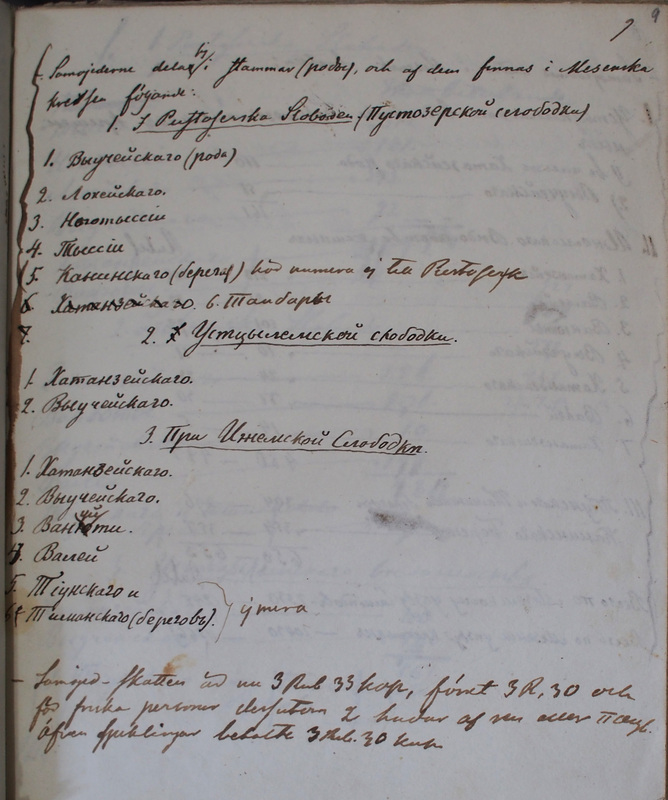Ethnographiska, historiska och statistiska anmärkningar. 009
Title
Ethnographiska, historiska och statistiska anmärkningar. 009
Description
|
Samojederne delar sig i stammar
(роды),
och af dem finnas i
The picture of Nenets communities began to evolve in the publications based on the Academic expeditions of the 18th century and later in the 19th century, when larger archival materials and First Census data could be used. However, the terms used for the types of Nenets communities derive both from Tundra Nenets practices and notions developed after the colonisation and during the development of taxation. Consequently, the Russian notion rod ‘family’, is strongly connected to the taxation practices. This is also reflected in the fact that the Nenets are listed according to the places where they were due to pay the tribute. The Tundra Nenets equivalents for family-based social categories would be yerkar or tenz. In addition to yerkar and tenz, ngesi ‘camp’, is also of importance: it is an everyday economic and social unit, whereas tenz and yerkar denote larger circles of social ties. Dolgich, Chomič, and Vasilʹev have summarised the often fragmented and variable data concerning the family names and the population numbers, and their conclusions are cited in the commentaries related to names. However, one should keep in mind that the social groups are not as stable as the notions might indicate. (Chomič 1966: 141–144; Chomič 1976: 96; Dolgich 1970; Vasilʹev 1979; Volžanina 2010: 17–24)
Mesenska kretsen
följande:The Mezenʹ uezd was founded in 1780, and it covered a large area from the River Mezenʹ to the Ural Mountains. Administratively, the uezd was part of the Arkhangel’sk oblast’ and Vologodskoe namestničestvo. In addition to the uezd centre, Mezenʹ, the slobodkas of Pustozersk, Ižma, and Ust-Cil’ma represented significant administrative centres. In 1835, the Nenets were given the right of possession of their ancestral lands, which were divided into the Kanin, Timan, and Bolšezmelʹskaja tundras. (Gosudarstvennyj archiv 2000: 264; Trošina & Minčuk 2015)
|
The Samoyeds are divided into tribes (rody), and in the Mezen uezd' there are the following: |
| I I Pustoserska Sloboden (Пустозерской слободки) |
I In Pustosersk Slobodka |
|
|
| II. Устцылемской слободки. |
II In Ustcylemsk slobodka |
|
|
| III. При Ижемской Слободке | III. In Ižemsk Slobodka |
|
|
|
Samojed-skatten
är nu 3 Rub 30 kop, förut 3R, 30 och The natives had paid the tribute (Ru yasak) in furs since the colonisation of the North and Siberia. Furs were one of the main exports of Russia and vital for the Empire’s economy. A regular amount of tax, consisting of both money and furs, was set after the 1822 Regulation for the administration of the natives or Speranskijʼs reform (Ustav ob upravlenii inorodcev). The 1835 law “On the administration of Samoyeds living in the Mezen’ district of the Arkhangel’sk region” (Ustav ob upravlenii samoedami, obitajuščimi v Mezenskom uezde Arxangelʹskoj gubernii) is roughly parallel to Speranskij’s reform, but concerns the Nenets living in the European Arctic. (Bachrušin 1955: 49–85; Forsyth 1992: 38–42; 156 Damešek & Remnev 2007 (eds.): 215-235)
för friska personer dessutom 2 hudar af ren eller псець.
Ru pesec TN ңохо ʻArctic fox’ (Alopex lagopus Linnaeus).
äfven sjuklingar betalte 3 Rub. 30 kop. |
The Samoyed tax is at the moment 3 roubles 30 kopecks, formerly 3R 30 and additionally two reindeer hides or псець for a healthy person. The sick also paid 3 roubles 30 kopecks. |

